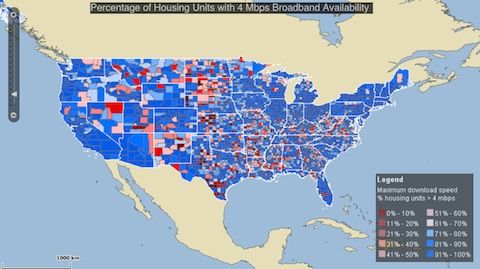
Above: Map of broadband access across the country, via the Federal Communication Commission's broadband mapping tool. Below: A map of AM radio set ownership across the county in 1930, from the U.S. Census Bureau, via The Daily Yonder.
 The Daily Yonder had a neat article yesterday about the rise of AM radio in rural areas across the country during the 1930s. Author Timothy Collins writes that the arrival of radio tranformed rural areas:
The Daily Yonder had a neat article yesterday about the rise of AM radio in rural areas across the country during the 1930s. Author Timothy Collins writes that the arrival of radio tranformed rural areas:
Along with agricultural mechanization and the automobile, radio changed rural America. It linked city with countryside and rural communities with themselves. By mid 1926, the government reported more than 500 stations owned by individuals, small businesses, churches, educational institutions, and major corporations like Westinghouse, RCA, General Electric, and Sears-Roebuck. By World War II, the number surpassed 940. As with the Internet today, radio adoption was uneven, based on geography, income, and race. A 1930 Census map shows clear distinctions, with higher ownership in the Northeast and North Central U.S., and on the West Coast, especially in California.
Looks like broadband internet access is the modern equivalent of AM radio as the game-changing technology for rural areas. When you compare the two maps above, eighty years later, broadband seems to be (roughly) following AM radio's uneven distribution pattern as it filters throughout the county.













